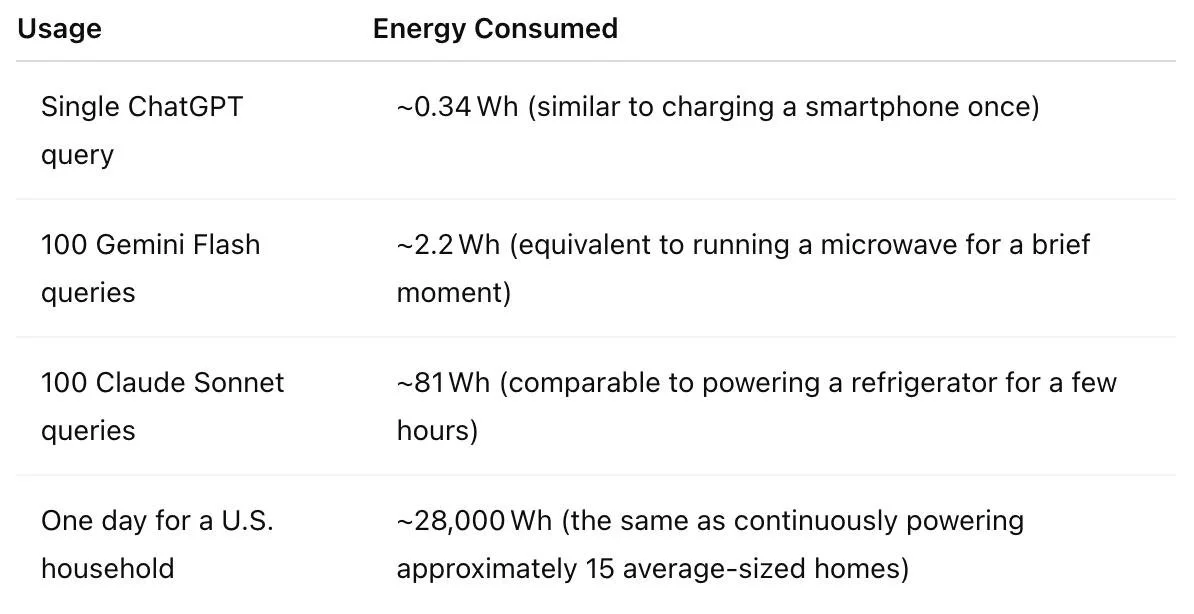Behind Every Great AI is an Even Greater Power Bill
Most people just hit the enter button and send their query off to the LLM without even thinking about power. And by power, I mean electricity. AI is rapidly becoming a part of everyday life, deeply integrated into our smartphones, smart assistants, business analytics, and even autonomous driving. The growth in AI adoption is explosive, but behind the seamless interactions with tools like ChatGPT, Google Gemini, and Anthropic Claude, there lies a hidden reality. These technologies consume significant amounts of power beyond other civilian-used technology that has been on the market.
Most people underestimate the power required for even a single AI query, let alone the energy demands of entire data centers that keep these sophisticated models running. Imagine the electricity used during a major sports event at a large stadium: bright lights, giant screens, and tens of thousands of devices charging and operating simultaneously. Now, picture that same level of energy consumption needed continuously by a single large-scale data center, sufficient to power nearly a million homes every day.
To better illustrate the energy demands, consider the following comparisons:
These examples underscore just how quickly small amounts of energy can add up at scale.
Expanding the Grid: Diverse Energy Solutions for AI's Future
The sheer scale of AI's power appetite is quickly surpassing what traditional fossil fuel-based grids can sustainably deliver. Oil, gas, and coal plants are simply unable to ramp quickly or cleanly enough to meet the constant and intensive electricity demands of modern AI and hyperscale data centers. According to the MIT Energy Initiative, a single large data center can consume as much electricity as 50,000 homes, and global data center power needs are projected to more than double by 2030, potentially reaching levels comparable to entire nations.
Relying solely on intermittent renewable sources like solar and wind without adequate storage can leave critical infrastructure vulnerable to instability and outages, according to Sourceability. To responsibly manage the rapid growth of AI, we must transition to a diversified clean energy portfolio, blending renewables with stable and dispatchable sources such as nuclear, geothermal, hydrogen, and advanced storage systems.
Solar Energy
Solar energy captures sunlight to produce electricity. It's one of the cleanest forms of renewable energy and is increasingly used to power data centers and technology infrastructure due to its scalability and decreasing costs.
Google is partnering with Intersect Power and TPG Rise Climate, developing solar and wind parks adjacent to AI data centers, targeting completion by 2027.
Google's commitment to a 1.5 GW solar development by 2030 with Energix highlights significant renewable energy investment.
Startups like Exowatt, backed by Sam Altman, offer modular solar-plus-thermal storage solutions specifically designed for AI infrastructure.
Nuclear Energy and SMRs
Nuclear power generates electricity through controlled nuclear reactions. Small Modular Reactors (SMRs) provide compact, reliable, and carbon-free power, making them particularly suited for powering energy-intensive AI data centers.
Google has entered pioneering agreements to purchase SMR-generated power from Kairos Power, aiming for substantial deliveries by 2035.
Microsoft is revitalizing nuclear infrastructure, with projects like restarting Three Mile Island Unit 1 to power data centers by 2028.
Significant investment ($3.2 billion) is pouring into SMRs from venture capital firms, highlighting the industry’s confidence in nuclear power for AI.
Geothermal Energy
Geothermal energy harnesses heat from beneath the Earth's surface to produce electricity. Its reliability and baseload power make it ideal for continuous energy demands like those of data centers.
Fervo Energy’s Project Red powers Google's Nevada data centers using an advanced geothermal system, demonstrating geothermal energy's viability for commercial applications.
Hydrogen Energy
Hydrogen fuel cells generate electricity through chemical reactions without combustion, providing a clean and efficient power source. They are increasingly utilized for backup power and off-grid energy solutions.
Microsoft and Plug Power have conducted pilots using hydrogen fuel cells to power data center servers, highlighting hydrogen's potential as a reliable backup energy source.
Hybrid Energy Systems
Hybrid energy systems combine multiple forms of renewable energy and storage technologies, optimizing reliability and efficiency for power-intensive operations.
The Stillwater Triple Hybrid Plant in Nevada integrates geothermal, solar photovoltaic, and concentrated solar power, providing consistent renewable energy ideal for large-scale data centers.
Why This Matters
AI's exponential growth strains data-center infrastructure, with demand potentially matching the power use of entire countries. This heightened energy consumption isn’t just electrical—cooling systems also consume considerable water, compounding environmental impact.
China is aggressively responding to these demands, significantly expanding its renewable energy capacity. In 2025 alone, China added approximately 500 GW of renewable power—including wind, solar, and hydro—to support massive AI initiatives in regions like Xinjiang and Qinghai. With data centers projected to consume 150–200 TWh of electricity annually, China’s investments could position it as a global leader in both AI and energy infrastructure (source).
OpenAI’s leadership suggests future AI costs could heavily depend on electricity prices, making energy efficiency and scale critical to staying competitive globally. Given China's advancements in renewable power, the U.S. must rapidly enhance its own energy infrastructure to maintain leadership in AI.
Toward an Electrically Smart Future
AI’s growing energy demands necessitate immediate action. Companies must strategically align their AI expansion with robust, sustainable energy solutions. Embracing renewable and nuclear options is no longer just environmentally responsible. It's strategically necessary as we enter the AI age. Without these proactive steps, AI's electricity appetite could shift from strategic advantage to costly grid liability, underscoring the need for intelligent energy management as much as intelligent algorithms.



